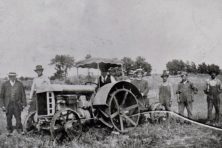True and Untrue Origins of ‘Saved by the Bell’
- Share
- Tweet
- Pin
- Share
This weekend is Mother’s Day weekend and, as is often the custom with this holiday, family members will be gathering to honor moms and grandmothers and great grandmothers throughout the country. While the occasion is certainly worthwhile, we all know that when family gathers awkward moments can often arise. Sometimes these moments are tense and sometimes they are just uncomfortable moments of silence.
With that in mind, this week’s column is devoted to sundry trivia that you can feel free to recite to defuse the tense moments or fill those awkward silences. Of course, whether you are admired for your erudition or reviled for inanity depends completely on your family.
“Saved by the Bell”
Before it was the name of a truly awful television sitcom, this phrase was widely used to express the notion of being saved at the last possible moment.
There are multiple theories of this phrase’s origin, but the simplest answer is usually the correct answer. In this case, the phrase comes from the sport of boxing when a boxer is knocked down and the bell marking the end of the round sounds before the referee ends the match with a count of 10. One of the earliest references to the phrase in this context occurred in the Fitchburg Daily Sentinel in 1893.
That’s the boring, though correct, origin. But, as sometimes happens, the incorrect origins are far more fun and interesting.
One of the stories that circulates about the origin of “saved by the bell” involves a a guard who was stationed on a castle’s battlements in the late 17th century who was charged with falling asleep at his post. The guard protested his innocence and, as proof of his innocence, claimed that the bell on St. Paul’s Cathedral had rung 13 times at the midnight hour.
Following an investigation, the guard’s story was proven true and he was acquitted of the charge. Hence, he was “saved by the bell.” Nice story. Reasonably plausible. Completely fabricated.
And then, venturing into the gruesome, there is the origin story involving an individual being buried alive. There are various versions of this story, attributing it to arising anywhere from the era of the Black Plague to the 18th century, but the essence of the story states that during [pick your time period] people were often unsure of whether an individual was actually dead or not. To resolve this dilemma, coffins were designed with a small hole through which a string passed. One end of the string was tied to the finger of the deceased (or not) and the other was attached to a small bell that was affixed to the tombstone.
So, if an individual wasn’t really dead, and was only faking death in order to get out of doing the dishes or cleaning out the horse stalls, and subsequently found themselves buried in the church graveyard, they need only wiggle their finger, which would alert someone above ground that they were alive. Whether they were then exhumed would then, presumably, be at the discretion of whoever heard the bell ring.
Once again, a nice story that certainly preys upon the almost universal fear of being buried alive, but this one, too, is completely untrue. Except for the fact that Franz Vester, of Newark, New Jersey, obtained U.S. Patent No. 81,437 on Aug. 25, 1868, for an “Improved Burial Case” that actually did incorporate a bell. Here’s a portion of Vester’s description that accompanied his patent application:
“The nature of this invention consists in placing on the lid of the coffin, and directly over the face of the body laid therein, a square tube, which extends from the coffin up through and over the surface of the grave, said tube containing a ladder and a cord, one end of said cord being placed in the hand of the person laid in the coffin, and the other end of said cord being attached to a bell on the top so that, should a person be interred ere life is extinct, he can, on recovery to consciousness, ascend from the grave and the coffin by the ladder; or, if not able to ascend by said ladder, ring the bell, thereby giving an alarm, and thus save himself from premature burial and death…”
I should note, at this point, that despite a patent being granted, there is no record of Vester’s coffins ever being used in any graveyard, anywhere in the world.
As a final note to this column, many believe the phrase “graveyard shift” originated from this whole business of the dead who are not dead ringing bells in the graveyard. And that someone who was employed to hang out listening for the ringing of bells was thereby working the “graveyard shift.”
Again, this theory is untrue. The phrase “graveyard shift” simply originated to define the late night work when the world is dark and spooky, i.e. like a graveyard.


